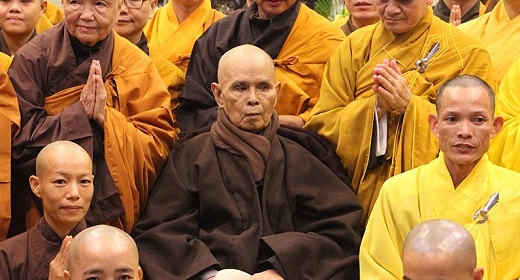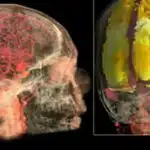Awaken: I once did a walking meditation with you, in France, at your Plum Village monastery.
 It is an honor to spend this time with you. We have a tradition here at awaken.com and that is to explore the idea of what it means to awaken. Could we explore this together?
It is an honor to spend this time with you. We have a tradition here at awaken.com and that is to explore the idea of what it means to awaken. Could we explore this together?
Thich Nhat Hanh: Looking at a speck of dust, the awakened person sees the universe… in the phenomenal world, things seem to exist as separate entities, which have a specific place: “this” is on the outside of “that.” When we deeply penetrate the principle of interdependence, we see that the sense of separateness is false. Each object is composed of and contains all others. In the light of meditation on interdependence, the concept of “one/many”collapses, and takes with it “large/small,” “inside/outside,” and all the others.
Awaken: So you are saying that to wake up is to see past our usual sense of separation and into the reality of interconnectedness?
TNH: The Indians have a wonderful example. If a grain of salt would like to measure the degree of saltiness of the ocean, to have a perception of the saltiness of the ocean, it drops itself into the ocean, and becomes one with it, and the perception is perfect… in order to understand something, you have to be one with that something.
Nowadays, nuclear physicists have begun to feel the same way. When they get deeply into the world of subatomic particles, they see their mind in it. An electron is first of all your concept of the electron. The object of your study is no longer separated from your mind. Your mind is very much in it. Modern physicists think that the word “observer“is no longer valid, because an observer is distinct from the object he observes. They have discovered that if you retain that kind of distinction, you cannot go very far in subatomic nuclear science. So they have proposed the word “participant.“ You are not an observer, you are a participant.
That is the way I always feel when I give a lecture. I don’t want the audience to be outside, to observe, to listen only. I want them to be one with me, to practice, to breathe. The speaker and the people who listen must become one in order for right perception to take place.
Awaken: it is gratifying that modern physics now recognizes what Buddha said, some 2500 years ago! Namely, that there is no separate self… You have a very beautiful and sweet way of explaining it, through the story of the cloud, which has no birthday. I have often told this story to my college students, who appreciate its simultaneous simplicity and depth… would you mind sharing that story with us?
TNH: Sometimes people ask you: “When is your birthday?” But you might ask yourself a more interesting question: “before that day, which is called my birthday, where was I?” Ask a cloud: “What is your date of birth?” Before you were born, where were you?”
If you ask the cloud, “How old are you? Can you give me your date of birth?” You can listen deeply, and you may hear a reply. You can imagine the cloud being born. Before being born it was the water on the ocean’s surface. Or it was in the river, and then it became vapor. It was also the sun, because the sun makes the vapor. The wind is there, too, helping the water to become a cloud. The cloud does not come from nothing; there has only been a change in form. It is not a birth of something out of nothing.
Sooner or later, the cloud will change into rain or snow or ice. If you look deeply into the rain, you can see the cloud. The cloud is not lost; it is transformed into rain, and the rain is transformed into healthy soil, and the soil into pumpkin plants and the pumpkin plants into blossoms – and with the help of our friends, the bees – the blossoms into pumpkins, and then into the pumpkin pie you eat. Today if you eat a piece of pumpkin pie, give yourself time to look at the pie and say:
“Hello, cloud! I recognize you.”
By doing that, you have insight and understanding into the real nature of the pie and the cloud. You can also see the ocean, the river, the heat, the sun, the soil, and the trees in the pie. Looking deeply, you do not see a real date of death for the cloud, nor a date of birth for the pumpkins. Nothing has been created. It was all already there. All that happens is that the cloud transforms into rain or snow. There is always a continuation. A cloud continues the ocean, the river, and the heat of the sun, and the rain continues the cloud.
Awaken: To share and assure my own understanding, looking deeply shows that not only are we like the cloud, but in a very real sense, we are the cloud! And the trees are an extension of our own lungs… What is outside of our body is just as vital as what is inside of our body! I love the way this story shows the interconnectedness of ourselves and nature, the fact that there is no logical place where we can draw a line between ourselves and the rest of the universe. I also love the way it demonstrates Buddha’s teaching of impermanence. We are all in the process of becoming. And so there is no real birth or death… Just a change in form. And yet there is so much fear around death. How can we deal with this fear?
TNH: It is real and deep wisdom to learn to look at things in terms of manifestation. If someone who is very close to you has passed away, and you define him or her as non-existing, you are mistaken. From nothing cannot be born something. From no one cannot be born someone. From something you cannot become nothing. From someone you cannot become no one. That is the truth. If the person who is close to, you does not manifest in the form that you are used to seeing or perceiving, that does not mean that he is non-existing. It does not mean that he is no longer there. If you look deeply, you can touch his or her presence in other forms of manifestation.
Awaken: Yes… I understand. And yet, I also understand how hard it is, in practical terms, when we actually lose someone.
TNH: One day, I took the hand of a young father, who had just buried his little son. I invited him to walk with me to discover his son in other forms. His son had come to Plum Village when he was very young and learned to enjoy vegetarian food. He gave me his allowance and extra pocket money and asked me to buy a plum tree and plant it for him. He wanted to participate in the work of supporting hungry children in the world by planting a fruit tree in Plum Village. He knew that a plum tree gives a lot of fruit. He knew that we could sell the fruit and send the money to hungry children in the third world.
He learned to do walking and sitting meditation, and he practiced the dharma very well. When he was sick, I went to Bordeaux and visited him in the hospital. He said to me, “Grandpa monk, I will do walking meditation for you.” he got down from his bed, although he was quite weak, and walked beautifully for me. Shortly after my visit, he died. The day of his cremation, I sprinkled the consecrated water, and chanted the Heart Sutra for him.
A week later, I took the hand of his father during a walking meditation, and showed him many other manifestations of his little boy. Together we visited the plum tree I planted for his son, and as we sat in the afternoon light, we saw his little boy waving to us from everywhere and from every branch.
Looking deeply into reality, you can discover many things. You can surmount so much suffering and counter many wrong perceptions. If we can abide peacefully in the ultimate dimension, we will not drown in the ocean of suffering, grief, fear, and despair… in the ultimate dimension, we have never been born, and we will never die. In the historical dimension, we live in forgetfulness, and we are rarely truly alive. We live like dead people.
Awaken: Can you explain living like “dead people”?
TNH: In his novel, The Stranger, Albert Camus describes his antihero as a man who “lives as though dead.” This is like living in a dark room with no light of awareness… the main character, out of despair and rage, shoots and kills someone. He receives the death sentence for his crime. One day, while lying on the bed in his prison cell, he looks up at the square-shaped skylight over him. Suddenly he becomes aware of and deeply in touch with the blue sky above. He has never seen the sky in that way before. Camus called this a moment of consciousness, which is a moment of awareness or of mindfulness. For the condemned man, it was the first time in his life that he really came into touch with the sky, and realized what a miracle it was…
When you light the lamp of awareness, you pass from sleep to awakening. The verb buddh in Sanskrit means “to wake up,” and one who wakes up is called a Buddha. Buddha is a person who is always awake. From time to time we have this awareness, so we are “from-time-to-time” Buddhas.
Awaken: What exactly do you mean when you speak of awareness?
TNH: Awareness simply means “being conscious of,” “remembering,” or “becoming acquainted with.” But we must use it in the sense of “being in the process of being conscious of,” or “ being in the process of remembering.” We have learned the word awareness in the sense of recognition, or bare attention, but the meaning doesn’t stop there. In awareness, there are also the elements concentration and understanding. Concentration and understanding together are both the intensity of awareness and the fruit of awareness. Every time the lamp of awareness is lit, concentration (one-pointedness) and understanding (clear-seeing) are naturally present… we may use the words “stopping” and “looking.”
If we can stop and look attentively, we succeed in seeing clearly. But what has to stop? Forgetfulness, dispersion, and confusion— the state of lost awareness, the absence of consciousness must stop. Stopping does not mean suppression. There is only the transformation of forgetfulness into remembrance, the absence of awareness into the presence of awareness.
Awaken: Is this a skill that we develop through meditation? And if so, what is meditation to you?
TNH: The practice of meditation is not an exercise in analysis, or reasoning. This sort of logic has no place in the practices of awareness, concentration, and understanding, and those of stopping and looking.
In Vietnam, when we cook a pot of dried corn, we concentrate the fire under the pot, and several hours later the kernels come loose and split open. When the sun’s rays beat down on the snow, the snow slowly melts. When a hen sits on her eggs, the chicks inside gradually take form until they are ready to pick their way out. These are images which illustrate the effect of practicing meditation.
Awaken: How would you sum up the aim of the practice?
TNH: The aim of this practice is to see the true face of reality, which is mind and mind-object. When we speak of mind, and of the outside world, we immediately are caught in a dualistic conception of the universe.
Awaken: So again, the aim would be to break through our dualistic worldview? How would we relate this to the usual aim of simply being present?
TNH: If reality is an interaction, an “interbeing,” how can we penetrate its essence? Zen teaches its practitioners just to observe, without judgment, without speculation. They say, “how can one conceive the inconceivable? Not thinking, that is the essence of Zen.”
When the sun shines continuously on a lotus flower, it opens widely, revealing its seed-heart. In the same way, through the activity of looking, reality gently reveals itself. In Meditation, the subject and object of pure observation are inseparable.
Awaken: I understand… being present enables us to penetrate the false veil of separation and enter into the universe of Oneness! I can’t help but wonder then, if there is no real separation between us, why is it that we can’t respect one another, with all of our differences, in the world?
TNH: In Christianity and in Buddhism, in both east and west, we have the notion of “the All,” the ultimate reality, the ground of being. Our Christian friends tend to think that Buddhists don’t like to conceive of “the All,” or the ground of being, as a person. That is what they resist the most. Some Christians believe that to Buddhists, “the All,” or the ground of being, is a non-person. But this is not true at all. Perhaps you have already realized this insight in your daily life. Every time you contemplate a tree, although you know that the tree is not a person, your relationship with the tree is not a relationship between a person and a non-person.
Awaken: Is that because it is an extension of us… because it is, in a sense, alive with spirit?
TNH: When I touch a rock, I never touch it as inanimate. The tree is spirit, mind; the rock is spirit, mind; the air, the stars, the moon, everything is consciousness… the great consciousness is manifesting itself. Everything is seen as consciousness. In the non-Buddhist spheres, very often they come to the same insight as the Buddha did.
Awaken: In this way, nature merits its own intrinsic respect, as something precious and sacred, in its own right…
TNH: In my experience, when I touch a tree, when I look at a bird, when I contemplate the water in the creek… I admire them, not because they have been created by God, and not because they have the Buddha nature. I admire them because they are trees, they are rocks, they are water… because the rock, to me, is nothing less than consciousness, than the spirit itself.
Awaken: Along with piercing through the veil of separation, what are some of the other benefits of meditation?
TNH: Non-fear is the greatest gift of meditation. With it, we can overcome grief and sorrow.
Awaken: It is so true that at the heart of all sorrow is fear… I think that the way many people experience this kind of sorrow is when they lose someone they love. The grief is all wrapped up with the fear that they are gone, as well as the fear of what life will be like without them. But just as the story of the cloud illustrated, there really is no birth and no death…
TNH: The moment of birth is only a moment of continuation. You can be perceived as a baby, the day of your so-called birth, and everyone thinks of you as now existing. But you already existed before that day.
Awaken: So you are dismissing the whole concept of creation!
TNH: That is why I prefer the expression “manifestation” to the word “creation.” This does not mean that we should not use the word “creation.” Of course we can do so, but we should understand that creation does not mean making something out of nothing. Creation is not something that is destroyed, and can become nothing. I very much like the term “wonderful becoming.” it is close to the true meaning of creation.
Awaken: Can you give another example of this idea of “wonderful becoming?”
TNH: When the Buddha was asked, “what is the cause of everything?“ He answered with very simple words. He said, “this is, because that is.“ It means that everything relies on everything else in order to manifest. A flower has to rely on non-flower elements in order to manifest. If you look deeply into the flower, you can recognize non-flower elements. Looking into the flower, you recognize the element sunshine; that is a non-flower element. Without sunshine, a flower cannot manifest. Looking at the flower, you recognize the element cloud; that is a non-flower element. Without clouds, the flower cannot manifest. Other elements are essential, such as minerals, soil, the farmer, and so on; a multitude of non-flower elements has come together, in order to help the flower manifest.
Awaken: There has just been a process of transformation… With the help of all of these interconnected elements, things morph and shift, and become something else, and this process continues on and on and on, such that nothing is ever really “born” in the conventional sense… just a process of continual becoming!
TNH: And when a manifestation ceases, it does not go anywhere.
Awaken: Master Thich Nhat Hanh, it has been a privilege to spend this time with you. Thank you.
This is one of Awaken’s DREAM Interviews, conducted by Donna Quesada, and All Answers are Verbatim from Thich Nhat Hanh.

















































